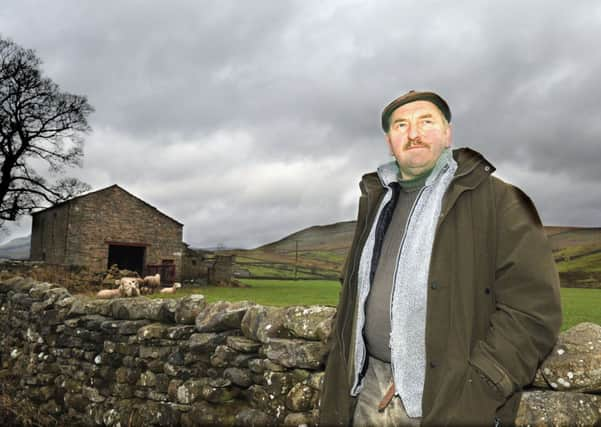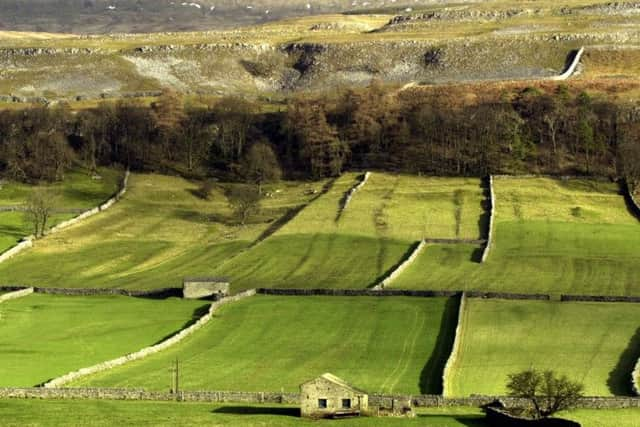Barns in a battle between conserving past and securing future of the Dales


Clarke Stones has lived in Arkengarthdale all his life. Just like his father and his father before that.
As well as working on the family farm, he has for as long as anyone can remember been the man who clears the roads. When the snow falls, Clarke is usually the first to know and before already remote communities become entirely cut off, he fires up the plough and slowly makes his way up hill and down dale.
Advertisement
Hide AdAdvertisement
Hide AdHowever, he recently turned 78 and was hoping to pass the responsibility on. He’d already found someone who was willing to help out on the farm and thought if he could convert the tumbledown barn on his land they would be able to live on site. It was, he thought, a win-win situation.


Unfortunately, the planning authority didn’t see it that way and his application was turned down. The barn is still derelict and Clarke is doing his best to fight on.
It’s the same story a few miles away in Upper Wensleydale where Tony Fawcett had similar plans for a derelict barn just down the road from his 700 acre farm. Tony is almost 60 and after a life spent tending a 55-strong dairy herd and flock of Swaledale sheep, he’s also being looking for ways of easing the pressure.
One of his nephews had expressed an interest in joining the business, but he needed somewhere to live. A conversion seemed like a perfect solution to what has become a widespread problem in the Dales. With property demand high, many younger generations of traditional farming families have been priced out of the market. Forced often to leave the Dales for a cheaper life elsewhere, when they go they also take any prospect of continuity with them.
Advertisement
Hide AdAdvertisement
Hide AdTony had planned to work on the conversion during quiet times on his Hardraw farm, however, after making initial enquiries, he was told permission would not be granted under Yorkshire Dales National Park Authority guidelines. Knowing the appeal process could take years, cost thousands and still lead to the same outcome, Tony decided to abandon his plans. However, if changes to the planning laws go ahead he might just be able reignite them.
The move is inevitably controversial. Currently anyone wanting to convert a barn has to submit a formal planning application and any benefit to the local community is weighed against likely impact on the landscape. Under the new proposals that scrutiny would be removed. Those wanting to take on a barn conversion would simply have to give notice of their intention.
To many farmers the change represents an injection of common sense into a intensely bureaucratic system.
Tony says: “The really crazy thing was that while they said the barn conversion didn’t meet current guidelines, they said I would be able to build a new house on the outskirts of the village. That can’t be right.”
Advertisement
Hide AdAdvertisement
Hide AdTony’s nephew has since moved to Richmond, but many believe a change in the planning regulations could prevent more young people leaving the Dales. However, the proposals face significant opposition.
“People who don’t get the decision they want tend to shout the loudest,” says Dr Malcolm Petyt, chairman of the Yorkshire Dales Society. “There is a hierarchy when it comes to planning. It’s always been possible to carry out barn conversions on the edge of settlements and there have been a huge number of those over the years which have been very successful. Next are those barns which are by roads. These can be converted, but we have to be sensitive about the likely impact on the character of the village.
“Finally there are the field barns, like those dotted around Swaledale and Arkengarthdale. A lack of suitable access makes conversion difficult, but it is more than that. They are an intrinsic part of the landscape. Ask people to think of the Dales and the image they will conjure up is of rolling green hills, drystone walls and barns.”
Modern requirements for housing and milking cattle along with changes to farming practices have made the barns redundant and it is estimated there are 6,000 or so scattered around the Dales. While not all would be ripe for conversion, if the changes are approved by a Government, which appears to favour greater planning flexibility, a significant number could be turned into dwellings.
Advertisement
Hide AdAdvertisement
Hide AdPart of the impetus behind the change is to ease the shortage of affordable housing in rural areas. However, the Yorkshire Dales Society fears it would in fact exacerbate the problem.
While the average house price across Yorkshire stands at £155,303, a typical home in Swaledale and Wensleydale is now £214,000. With average salaries just topping £20,000, it means home ownership is a far-off dream for many.
“It’s easy to look around at these redundant buildings and see them as a convenient stock of affordable housing, but it’s not that simple,” says Dr Petyt. “Conversion is not a cheap option and often their location simply doesn’t work. Take a typical family looking for affordable housing. They are on a low income, so why would they want to live in a remote part of the Dales which means they will have to run two cars? What they want is new affordable housing built on the edge of an existing village where they can have much greater access to services.
“There is no provision in the changes being discussed to insist they be sold to local people. The fact is that these isolated barns will become upmarket second homes and further inflate the local housing market. One barn conversion close to where I live recently sold for £400,000 and I fear that will become the norm rather than the exception.”
Advertisement
Hide AdAdvertisement
Hide AdPrevious changes to the planning laws have excluded National Parks, an acknowledgement, says Dr Petyt, that they are a special case.
“This time there is no such exemption and I fear it will lead to one big free-for-all. The most worrying thing is that they don’t even have to convert the existing barn, but will be quite within their rights to demolish and rebuild an entirely new property, albeit on the existing footprint.
“I am told that some farmers think of these barns as assets, the same as their sheep and their cows, but we have to think long-term because the impact of what we do now will be felt for centuries.”
Ministers are currently debating the issue and it is not known when a decision will be made. What no-one is denying is that there is a problem, however, the YDS says research has identified areas ripe for new developments. “Local landowners were asked for their suggestions and there is now a register of all suitable plots,” says Dr Petyt. “However, anyone wishing to build a development would have to provide some affordable housing. Clearly the profit margins are much narrower and our fear is that if the changes go ahead it would put developers off taking on these sites. Why would they commit to affordable housing when they can carry out much more lucrative barn conversions?”
Advertisement
Hide AdAdvertisement
Hide AdOne of the most bitter rows seen in the Dales concerned Sharon Spensley and her partner David Winspear. For four years Sharon’s father James, who wanted to convert a barn on his land for his daughter to live in, was locked in a fierce battle with the planning authority who refused to grant the application, despite confirming that had he wanted to turn it into a holiday home he would have been given the go-ahead.
The row over Cams House, near Askrigg, which finally came to an end in 2006 when the authority was finally persuaded to grant permission for a conversion, encapsulated the frustrations of the system and there are those who believe the planned changes are vital if the Dales is to survive as a living breathing landscape.
“Sadly it is 15 years too late for many local families who have already been forced to leave the Dales,” says John Blackie, North Yorkshire County Councillor and member of the YDNPA, who has long campaigned for changes. “If there had been a flexible policy they would still be living here and their children would be gracing the classrooms of our wonderful small schools.
“Instead heads anxiously tune into the local bush telegraph of any news of families moving away because all it takes is a small handful of children to leave and their school is in trouble. We have already lost too many people, we can’t afford to lose more.”
‘Developers charter’ fears
Advertisement
Hide AdAdvertisement
Hide AdIn April 2012, the Government announced significant changes to planning law in England which it said was designed to speed up decisions and boost house building.
Under the National Planning Policy Framework, local authorities are required to work out future housing needs in their area, and then allocate sufficient land to meet it.
However, Ministers said the system was fraught with delays and slimmed down 1,000 pages of regulations to less than 100 as well as introducing a “presumption in favour of sustainable development”. Critics claim the change amounts to a “developers’ charter” at the expense of environmental concerns.